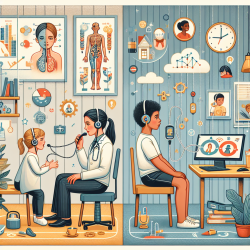Introduction
The intersection of public health and urban planning is a burgeoning field that holds significant promise for improving population health outcomes. A recent study, titled "Physical activity trails in an urban setting and cardiovascular disease morbidity and mortality in Winnipeg, Manitoba, Canada: a study protocol for a natural experiment," provides valuable insights into how urban trails can impact cardiovascular health. While the study focuses on adults, the implications for children's health and development, especially in the context of speech and language pathology, are profound.
Understanding the Study
The research conducted in Winnipeg, Canada, evaluated the impact of newly constructed urban trails on cardiovascular disease (CVD) morbidity and mortality. These trails, built between 2008 and 2010, span multiple neighborhoods and are designed for various physical activities, including cycling, walking, and running. The study employs an interrupted time series analysis to assess the impact of these trails on CVD outcomes among adults aged 30-65 residing near the trails.
Key findings from the study suggest that individuals living in proximity to these trails experienced a reduction in CVD-related morbidity and mortality. The study also highlights the importance of the built environment in promoting physical activity and its potential to serve as a cost-effective public health intervention.
Implications for Child Health and Speech Language Pathology
While the study primarily focuses on adult populations, the findings can be extrapolated to children, particularly in the realm of speech and language pathology. Physical activity is known to enhance cognitive function, which is crucial for language development in children. By encouraging physical activity through urban trails, we can potentially improve language outcomes in children.
Here are some ways practitioners can leverage these findings:
- Promote Physical Activity: Encourage schools and communities to incorporate urban trails into their physical education programs. This can help children develop better cardiovascular health, which is linked to improved cognitive function and language skills.
- Advocate for Built Environment Improvements: Speech language pathologists can advocate for urban planning that includes trails and green spaces, recognizing their role in promoting physical and cognitive health.
- Integrate Outdoor Activities in Therapy: Consider incorporating outdoor activities that utilize urban trails into therapy sessions. This can provide a stimulating environment that supports both physical activity and language development.
Encouraging Further Research
The study's findings open the door for further research into the impact of the built environment on child health outcomes. Speech language pathologists can collaborate with urban planners and public health officials to conduct studies that specifically target children and measure the impact of physical activity on language development.
Potential research questions include:
- How does regular use of urban trails influence language development milestones in children?
- What is the impact of physical activity on specific speech and language disorders?
- How can urban trails be designed to maximize their benefits for children's cognitive and language development?
Conclusion
The integration of urban trails into city planning is more than just a public health initiative; it is a step towards holistic child development. By understanding and implementing the findings of this study, speech language pathologists can contribute to creating environments that foster better health and developmental outcomes for children.
To read the original research paper, please follow this link: Physical activity trails in an urban setting and cardiovascular disease morbidity and mortality in Winnipeg, Manitoba, Canada: a study protocol for a natural experiment.










